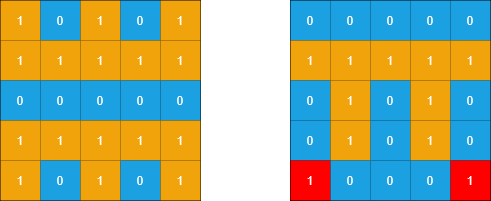- {x}
- Redistribute Characters to Make All Strings Equal
- Maximum Number of Removable Characters
- Merge Triplets to Form Target Triplet
- The Earliest and Latest Rounds Where Players Compete
- Find a Peak Element II
- Depth of BST Given Insertion Order
- Largest Odd Number in String
- The Number of Full Rounds You Have Played
- Count Sub Islands
- Minimum Absolute Difference Queries
- Count Salary Categories
- Game of Nim
- Remove One Element to Make the Array Strictly Increasing
- Remove All Occurrences of a Substring
- Maximum Alternating Subsequence Sum
- Design Movie Rental System
- Maximum Product Difference Between Two Pairs
- Read More...

Count Sub Islands
You are given two m x n binary matrices grid1 and grid2 containing only 0's (representing water) and 1's (representing land). An island is a group of 1's connected 4-directionally (horizontal or vertical). Any cells outside of the grid are considered water cells.
An island in grid2 is considered a sub-island if there is an island in grid1 that contains all the cells that make up this island in grid2.
Return the number of islands in grid2 that are considered sub-islands.
Example 1:

Input: grid1 = [[1,1,1,0,0],[0,1,1,1,1],[0,0,0,0,0],[1,0,0,0,0],[1,1,0,1,1]], grid2 = [[1,1,1,0,0],[0,0,1,1,1],[0,1,0,0,0],[1,0,1,1,0],[0,1,0,1,0]] Output: 3 Explanation: In the picture above, the grid on the left is grid1 and the grid on the right is grid2. The 1s colored red in grid2 are those considered to be part of a sub-island. There are three sub-islands.
Example 2:

Input: grid1 = [[1,0,1,0,1],[1,1,1,1,1],[0,0,0,0,0],[1,1,1,1,1],[1,0,1,0,1]], grid2 = [[0,0,0,0,0],[1,1,1,1,1],[0,1,0,1,0],[0,1,0,1,0],[1,0,0,0,1]] Output: 2 Explanation: In the picture above, the grid on the left is grid1 and the grid on the right is grid2. The 1s colored red in grid2 are those considered to be part of a sub-island. There are two sub-islands.
Constraints:
m == grid1.length == grid2.lengthn == grid1[i].length == grid2[i].length1 <= m, n <= 500grid1[i][j]andgrid2[i][j]are either0or1.
1905. Count Sub Islands
Description
Given two binary matrices grid1 and grid2 of size m x n, where 1 represents land and 0 represents water, find the number of sub-islands in grid2. A sub-island in grid2 is an island whose cells are all also part of an island in grid1.
Solution: Depth-First Search (DFS)
This problem can be efficiently solved using Depth-First Search (DFS). The core idea is to iterate through grid2. Whenever we encounter a land cell (value 1), we initiate a DFS to explore the entire connected island. During this DFS, we simultaneously check if each cell in the island is also land in grid1. If even one cell in the grid2 island is water in grid1, the entire grid2 island is not a sub-island.
Algorithm
- Iterate: Traverse
grid2row by row and column by column. - DFS Initiation: If a cell
grid2[i][j]is 1 (land), start a DFS exploration from that cell. - DFS Exploration:
- Mark the current cell as visited in
grid2by setting it to 0. - Check if the corresponding cell in
grid1is also 1. If not, the island is not a sub-island, so we setisSubIslandto false. - Recursively explore the four adjacent cells (up, down, left, right).
- Mark the current cell as visited in
- Sub-island Check: After the DFS for a connected component completes, if
isSubIslandis still true, increment the count of sub-islands.
Time and Space Complexity
- Time Complexity: O(M * N), where M and N are the dimensions of the grid. We visit each cell at most once.
- Space Complexity: O(M * N) in the worst case, due to the recursive call stack of the DFS. In practice, it could be less depending on the structure of the islands.
Code (Python)
def countSubIslands(grid1, grid2):
m, n = len(grid1), len(grid1[0])
count = 0
def dfs(i, j):
if not (0 <= i < m and 0 <= j < n and grid2[i][j] == 1):
return True # Base case: out of bounds or water
grid2[i][j] = 0 # Mark as visited
is_sub_island = grid1[i][j] == 1 # Check if this cell is land in grid1
is_sub_island &= dfs(i + 1, j) # Explore down
is_sub_island &= dfs(i - 1, j) # Explore up
is_sub_island &= dfs(i, j + 1) # Explore right
is_sub_island &= dfs(i, j - 1) # Explore left
return is_sub_island
for i in range(m):
for j in range(n):
if grid2[i][j] == 1:
if dfs(i, j):
count += 1
return count
The code in other languages (Java, C++, Go, TypeScript, JavaScript) follows a very similar structure, using the same DFS logic. The primary difference would be in syntax and data structure handling specific to each language. The core algorithm remains the same.